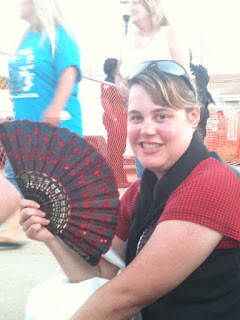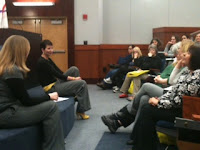October is Meet the Blind Month so hello! November 1st begins the Braille Readers are Leaders program where adults from all over the country are going to
read braille and lots of it! I am on a team called “The Honey Badgers”. We will
be reading braille from November 1st till January 4th.
January 4th marks the birthday of a fabulous person, Louis Braille,
the inventor of Braille. I just happen to share a birthday with this man and we
would like to share a challenge for you. All 5 of us below will be reading
braille and we hope you will be able to sponsor our pages read. You can donate through Pay Pal on the right of this page with any amount you choose.
We are raising money for braille literacy and the money we raise will go to the BELL Program. It is a program in many states that works to foster braille literacy in children through a summer program.
Why are we doing this?
Currently 75% of the nation’s blind are unemployed. Only 10%
of the nation’s blind are reading braille. Out of those employed 90% read
braille. Coincidence? I think not!! Braille is a tool for literacy and
ultimately success! Yet there are so many misconceptions about what it is and can
do. It is not hard to learn, and benefits kids and adults in numerous ways. And since we are Honey Badgers, we do what we want!
And the Honey Badgers are...
Ivan "reading braille nonstop" Walker
Ivan is currently a blind chef in Mobile, Alabama.
He graduated from The Art Institute of Atlanta with a degree in Culinary Arts.
Ivan worked as Executive Chef at The W Hotel Atlanta for 11 years. He now has
his own catering business in Mobile, where he specializes in southern style
cuisine. He graduated from the Louisiana Center for the Blind in 2010. Ivan
also completed The Randolph Sheppard Program in 2011. The program is designed
to develop business enterprising nationwide, and offers an opportunity for
blind business owners to own and operate their own businesses on federal
property. Ivan is also a member of Alabama's NFB Affiliate, and Alabama's
National Association of Blind Merchants Division. He attributes his independence
and success to his training at Louisiana Center for the Blind. Ivan uses
Braille as an important tool in his professional life, and his favorite quote
is "just because you are blind, it doesn't mean you can't do."
Danielle "braille fingers" Fernandez
Danielle is a student at Louisiana Tech University working on a degree in communications. When she was in the
third grade she was taught braille but since she had some vision she didn’t use
braille and her teachers did not encourage it. Everything changed when she lost her
vision in 2002. She still remembered how to read contracted braille but she was
a very slow reader. Then in 2010 she attended the Louisiana Center for the
Blind. When she first got there she was clocked in at reading 26 words per
minute, but when she left she was up to 90 words per minute. “To read is to
achieve.”
Liz "the braille wiz" Graves
Even though Liz was born blind, she didn’t learn Braille
until she was much older. She got a handful of lessons on a Perkins when she
was 19, learned the alphabet and numbers, and later taught herself some of the
contractions before attending the Louisiana Center for the Blind. Liz didn’t
really read Braille until she attended LCB. While there, she got her reading
speed up to 80 words a minute. Liz had also never used a long cane until LCB.
She liked cane travel so much that she decided to enroll in the Louisiana Tech
O&M master’s program where she is in her last quarter of the program, and
works for the Lincoln Parish school district teaching blind children cane
travel. Liz does not have much free time right now between school and the
Lincoln kids, but in her free time she enjoys hanging out with friends,
shopping, and eating sushi. “I’ll finally be able to get my reading on with
this Braille challenge!”
Alex "the braille bandido" Castillo
Alex currently resides in Lincoln NE
and is an orientation counselor at the Nebraska Center for the Blind
and Visually Impaired. He has served as a former president of the
New York association of Blind Students and is a proud graduate of the
Louisiana Center for the Blind, where he received Braille training. He
holds a BA in Political Science and Psychology from Hunter College in
New York, and has been involved and started several disability
advocacy projects in New York City. Alex states "Braille is literacy".
and is an orientation counselor at the Nebraska Center for the Blind
and Visually Impaired. He has served as a former president of the
New York association of Blind Students and is a proud graduate of the
Louisiana Center for the Blind, where he received Braille training. He
holds a BA in Political Science and Psychology from Hunter College in
New York, and has been involved and started several disability
advocacy projects in New York City. Alex states "Braille is literacy".
Conchita "the mean braille reader" Hernandez
Conchita Hernandez resides in Lincoln Nebraska and works at The Commission for the Blind and Visually Impaired as a rehabilitation
counselor. She attended Louisiana Tech University where she earned a mastersdegree in Teaching Blind Students and Saint Mary’s College of California where
she earned her bachelor’s degree in International Studies and Spanish. Conchita
holds a National Certification in Literary Braille. She received her blindness
training from the Nebraska Center for the Blind and Visually Impaired where she
was introduced to braille for the first time. And she states, “It is vital for
low vision children to learn braille in order to become confident, competent
adults.”
So please join us in raising awareness about braille
literacy and helping us raise money for such a great cause!

































